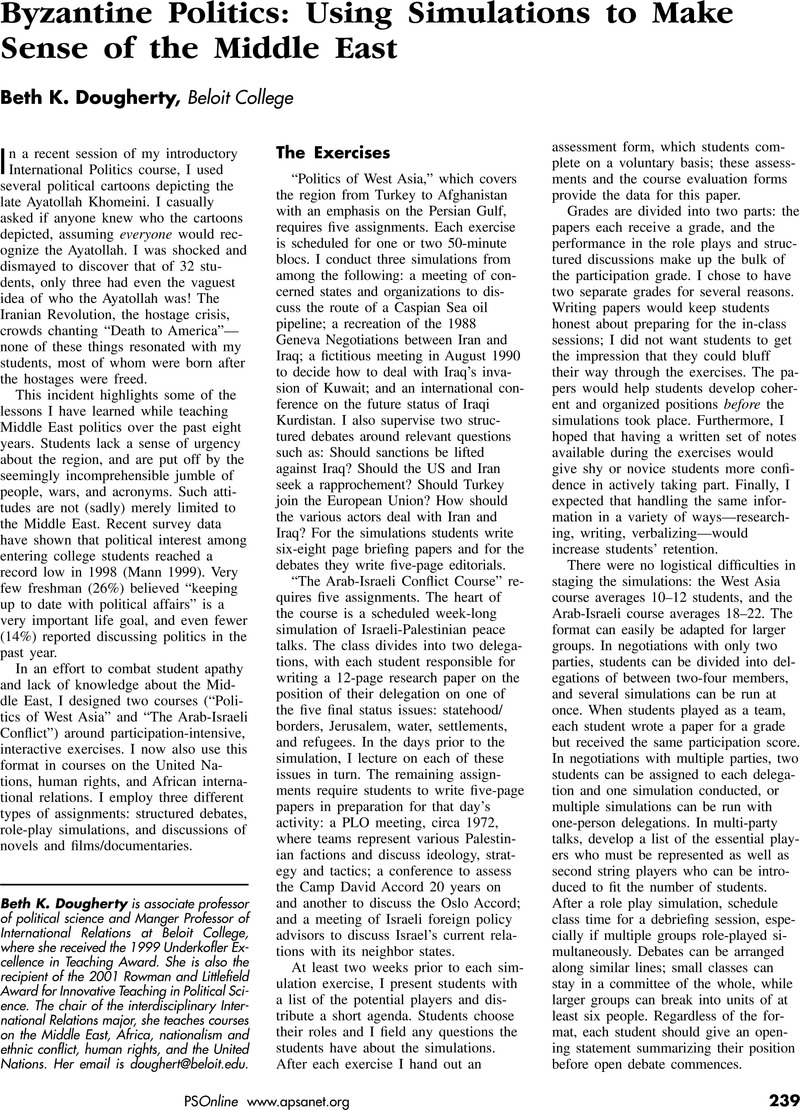Crossref Citations
This article has been cited by the following publications. This list is generated based on data provided by Crossref.
Pappas, Christine
and
Peaden, Charles
2004.
Running for Your Grade: A Six-Week Senatorial Campaign Simulation.
PS: Political Science & Politics,
Vol. 37,
Issue. 4,
p.
859.
Chasek, Pamela S.
2005.
Power Politics, Diplomacy and Role Playing: Simulating the UN Security Council's Response to Terrorism.
International Studies Perspectives,
Vol. 6,
Issue. 1,
p.
1.
Thies, Cameron G.
2005.
How to Make the Most of Your Summer Study Abroad Teaching Experience.
PS: Political Science & Politics,
Vol. 38,
Issue. 1,
p.
83.
Stover, William James
2005.
Teaching and Learning Empathy: An Interactive, Online Diplomatic Simulation of Middle East Conflict.
Journal of Political Science Education,
Vol. 1,
Issue. 2,
p.
207.
Franke, Volker
2006.
The Meyerhoff Incident: Simulating Bioterrorism in a
National Security Class.
PS: Political Science & Politics,
Vol. 39,
Issue. 1,
p.
153.
KRAIN, MATTHEW
and
LANTIS, JEFFREY S.
2006.
Building Knowledge? Evaluating the Effectiveness of the Global Problems Summit Simulation.
International Studies Perspectives,
Vol. 7,
Issue. 4,
p.
395.
Wheeler, Sarah M.
2006.
Role-Playing Games and Simulations for International Issues Courses.
Journal of Political Science Education,
Vol. 2,
Issue. 3,
p.
331.
Galatas, Steven E.
2006.
A Simulation of the Council of the European Union:
Assessment of the Impact on Student Learning.
PS: Political Science & Politics,
Vol. 39,
Issue. 1,
p.
147.
STOVER, WILLIAM JAMES
2007.
Simulating the Cuban Missile Crisis: Crossing Time and Space in Virtual Reality.
International Studies Perspectives,
Vol. 8,
Issue. 1,
p.
111.
Pressman, Jeremy
2008.
The Arab-Israeli Conflict and the Case ofThe Lemon Tree.
International Studies Perspectives,
Vol. 9,
Issue. 4,
p.
430.
Powner, Leanne C.
and
Allendoerfer, Michelle G.
2008.
Evaluating Hypotheses about Active Learning.
International Studies Perspectives,
Vol. 9,
Issue. 1,
p.
75.
Burgos, Russell A.
2008.
Teaching the Iraq War.
PS: Political Science &
Politics,
Vol. 41,
Issue. 1,
p.
173.
Kiasatpour, Soleiman
and
Whitfield, Christopher
2008.
Politics in Action: Wolves, Snowmobiles, and Bison and
the Greater Yellowstone Ecosystem.
PS: Political Science &
Politics,
Vol. 41,
Issue. 1,
p.
193.
Youde, Jeremy
2008.
Crushing Their Dreams? Simulations and Student Idealism.
International Studies Perspectives,
Vol. 9,
Issue. 3,
p.
348.
Belloni, Roberto
2008.
Role-Playing International Intervention in Conflict Areas: Lessons from Bosnia for Northern Ireland Education.
International Studies Perspectives,
Vol. 9,
Issue. 2,
p.
220.
Carlson, Jon D.
2009.
“Who Are You Wearing?” Using the Red Carpet Question Pedagogically.
International Studies Perspectives,
Vol. 10,
Issue. 2,
p.
198.
Simpson, Archie W.
and
Kaussler, Bernd
2009.
IR Teaching Reloaded: Using Films and Simulations in the Teaching of International Relations.
International Studies Perspectives,
Vol. 10,
Issue. 4,
p.
413.
Sasley, Brent E.
2010.
Teaching Students How to Fail: Simulations as Tools of Explanation.
International Studies Perspectives,
Vol. 11,
Issue. 1,
p.
61.
Sands, Eric C.
and
Shelton, Allison
2010.
Learning by Doing: A Simulation for Teaching How Congress Works.
PS: Political Science & Politics,
Vol. 43,
Issue. 1,
p.
133.
Krain, Matthew
2010.
The Effects of Different Types of Case Learning on Student Engagement.
International Studies Perspectives,
Vol. 11,
Issue. 3,
p.
291.



